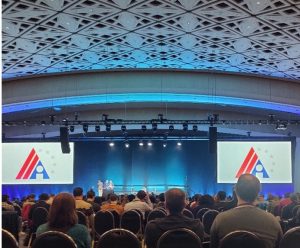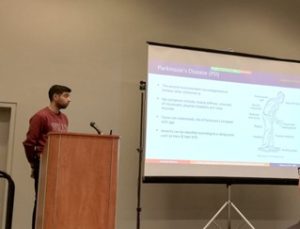This blog post is written by AI CDT Student Amarpal Sahota
I attended the 37th AAAI Conference on Artificial Intelligence from the 7th of February 2023 to the 14th February. This was my first in person conference and I was excited to travel to Washington D.C.
The conference schedule included Labs and Tutorials February 7th – 8th , the main conference February 9th – 12th followed by the workshops on February 13th – 14th.
Arriving and Labs / Tutorials
I arrived at the conference venue on 7th February to sign in and collect my name badge. The conference venue (Walter E. Washington Convention Center) was huge and had within it everything you could need from areas to work or relax to restaurants and of course many halls / lecture theatres to host talks.
I was attending the conference to present a paper at the Health Intelligence Workshop. Two of my colleagues from the University of Bristol (Jeff and Enrico) were also attending to present at this workshop (we are pictured together below!).

The tutorials were an opportunity to learn from experts on topics that you may not be familiar with yourself. I attended tutorials on Machine Learning for Causal Inference, Graph Neural Networks and AI for epidemiological forecasting.
The AI for epidemiological forecasting tutorial was particularly engaging. The speakers were very good at giving an overview of historical epidemiological forecasting methods and recent AI methods used for forecasting before introducing state of the art AI methods that use machine learning combined with our knowledge of epidemiology. If you are interested, the materials for this tutorial can be accessed at : https://github.com/AdityaLab/aaai-23-ai4epi-tutorial .
Main conference Feb 9th – Feb 12th
The main conference began with a welcome talk in the ‘ball room’. The room was set up with a stage and enough chairs to seat thousands. The welcome talk introduced included an overview of the different tracks within the conference (AAAI Conference of AI, Innovative Application of AI, Educational Advances in AI) , statistics around conference participation / acceptance and introduced the conference chairs.

The schedule for the main conference each day included invited talks and technical talks running from 8:30 am to 6pm. Each day this would be followed by a poster session from 6pm – 8pm allowing us to talk and engage with researchers in more detail.
For the technical talks I attended a variety of sessions from Brain Modelling to ML for Time-Series / Data Streams and Graph-based Machine Learning. Noticeably, all of the sessions were not in person. They were hybrid, with some speakers presenting online. This was disappointing but understandable given visa restrictions for travel to the U.S.
I found that many of the technical talks became difficult to follow very quickly with these talks largely aimed at experts in the respective fields. I particularly enjoyed some of the time-series talks as these relate to my area of research. I also enjoyed the poster sessions that allowed us to talk with fellow researchers in a more relaxed environment and ask questions directly to understand their work.
For example, I enjoyed the talk ‘SVP-T: A Shape-Level Variable-Position Transformer for Multivariate Time Series Classification‘ by PhD researcher Rundong Zhuo. At the poster session I was able to follow up with Rundong to ask more questions and understand his research in detail. We are pictured together below!

Workshops Feb 13th – 14th
I attended the 7th International Workshop On Health Intelligence from 13th to 14th February. The workshop began with opening remarks from the Co-chair Martin Michalowski before a talk by our first keynote speaker. This was Professor Randi Foraker who spoke about her research relating to building trust in AI for Improving Health Outcomes.
This talk was followed by paper presentations with papers on related topics grouped into sessions. My talk was in the second session of the day titled ‘Classification’. My paper (pre-print here) is titled ‘A Time Series Approach to Parkinson’s Disease Classification from EEG’. The presentation went reasonably smoothly and I had a number of interesting questions from the audience about applications of my work and the methods I had used. I am pictured giving the talk below!

The second half of the day focused on the hackathon. The theme of the hackathon was biological age prediction. Biological ageing is a latent concept with no agreed upon method for estimation. Biological age tries to capture a sense of how much you have aged in the time you have been alive. Certain factors such as stress and poor diet can be expected to age individuals faster. Therefore two people of the same chronological age may have different biological ages.
The hackathon opened with a talk on biological age prediction by Morgan Levin (The founding Principal Investigator at Altos Labs). Our team for the hackathon included four people from the University of Bristol – myself , Jeff , Enrico and Maha. Jeff (pictured below) gave the presentation for our team. We would have to wait until the second day of the conference to find out if we won one of the three prizes.

The second day of the workshop consisted of further research talks, a poster session and an awards ceremony in the afternoon. We were happy to be awarded the 3rd place prize of $250 for the hackathon! The final day concluded at around 5pm. I said my good byes and headed to Washington D.C. airport for my flight back to the U.K
